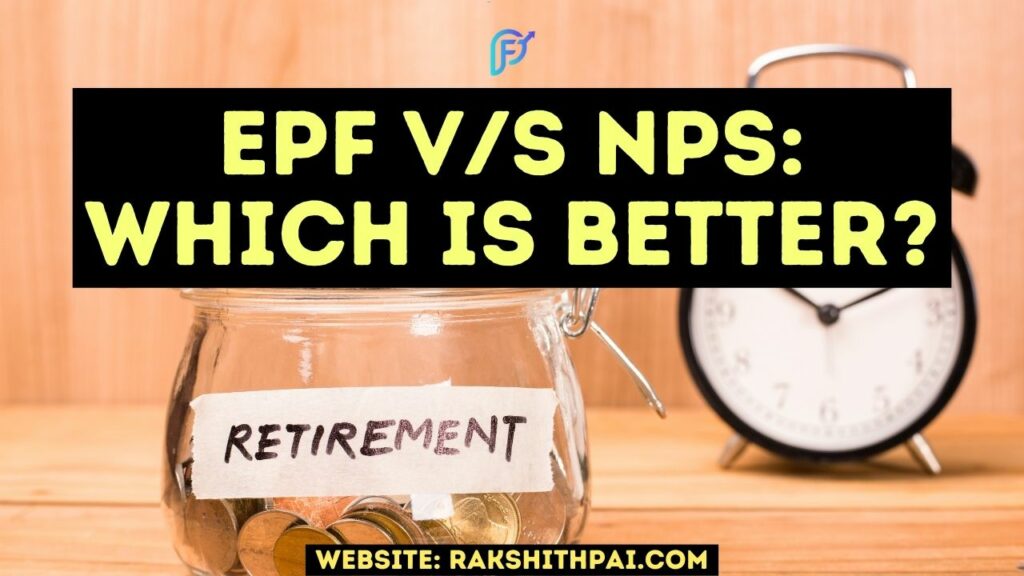Table of Contents
What are EPF and NPS?
NPS and PF are pension schemes offered by the Central government. These schemes allow the Indian general public (mainly in the private sector) to subscribe to their own pension.
The pension has always been one of the major driving factors for Indians to employ themselves in government institutions. But, with the introduction of the Provident Fund and the National Pensions Scheme, every one of the subscribers gets to build their own retirement pension fund.

What is EPF?
To ensure that those working in India’s formal economy have access to the resources they’ll need after retirement, the Employees’ Provident Fund was established. It is a government agency charged with carrying out its statutory duties.
Each EPF-eligible worker must contribute a certain percentage of their gross pay to their EPF account, and their employer must match that amount up to 12% of the Basic salary and Dearness allowance. The accumulated corpus, along with any interest that has been accrued, will be distributed to the employee at some point in the future.
12% of an employee’s base pay and dearness allowance goes into EPF, with an equivalent amount being deposited by the company. Deposits in the EPF now earn an annual interest rate of 8.15% (FY 2023).
EPF is also a prominent EEE category investment wherein the investment made, the interest income earned, and the maturity due amount are completely tax-free. Withdrawals of interest from an EPF account are not subject to taxation. When an employee retires, they get a lump-sum payment that includes any interest earned up to that point.
What is NPS?
In order to promote savings, the Government of India has made the program accessible to every Individual and, from a security point of view, has introduced several appealing perks for NPS account holders.
The National Pension System (NPS) is based on a unique Permanent Retirement Account Number (PRAN), which is provided to every subscriber.
You can seek tax exemption up to Rs. 50,000 under Section 80CCD (1B). This benefit is over the limit of Rs. 1,50,000 under Section 80C.
Employer contribution advantage is restricted to 7.5 lakhs invested as Employer contribution towards NPS, PF, and superannuation.
NPS is another EEE category investment where each and every subscriber gets to invest up to Rs. 2 lakh per annum (As mentioned above) and claim tax benefits along with tax benefits towards the interest income and the maturity value when the subscriber reaches 60 years of age.
What is the difference between NPS and EPF for retirement planning?
The following are the major differences between the two schemes:
- EPF is more like a savings fund account with a shorter duration of 15 years as compared to the NPS, which has an overall maturity period of until the subscriber reaches 60 years of age.
- The Government of India sets the EPF interest rate, but the National Pension Scheme’s return is based on market volatility.
- The EPF allows you a tax deduction of up to 1.5 lakh rupees under Section 80c of the Income Tax Act, but the NPS offers complete tax advantages of up to 2 lakh rupees under Sections 80CCD (2) and 80CCD (1).
- Another key distinction is that the EPF is only accessible to paid employees working in diverse private firms. In contrast, NPS can be subscribed to by any Indian citizen, including self-employed people aged 18 to 60.
- In the case of EPF, 12% of the employee’s basic income is withheld from the EPF payment, which is not necessary under NPS. Because NPS is a voluntary retirement fund.
- In EPF, the minimum contribution is Rs. 1,800 (12% of Base Salary plus DA) and Rs. 1000 in NPS.
- Return-wise, EPF gives a better yield, ranging from over 8% up to 10%+ at times, Whereas NPS yields range between 8% and 9.5% (but, volatile) because NPS returns are predominantly market-linked.
NPS v/s EPF, Which is Better?
Both the National Pension System (NPS) and the Employees’ Provident Fund (EPF) are popular alternatives for retirement planning in India. However, they have different traits and aims.
EPF is a statutory provident fund withdrawal from your pay, with the main purpose of generating a retirement corpus. But the maturity period is just 15 years at most. The money received on retirement is tax-free. On the other side, NPS is a voluntary savings vehicle with an emphasis on accumulation for retirement.
As an assumption, if you are approaching retirement in the next few years and have already collected money through EPF, moving to NPS now may not make a major impact.
You might wait to realize the EPF money and then invest according to your aims and aspirations. If you expect to produce consistent income throughout retirement, consider investing with that purpose in mind.
If you are not seeking regular income and want to invest in NPS, you can still do so even if you are not currently employed. You can freely create an NPS account until the age of 70 and invest your money. However, your money will remain locked until you reach the age of 60, which may be useful if you choose to postpone consumption until that age.
So basically, EPF is more like an instrument to save and fund those expenses that one has to bear before retirement. Such as children’s marriage expenses, owning a home, etc., whereas an NPS is a retirement pension account that fulfills your retirement goals post-retirement, mostly by the age of 60 and later.
Drawbacks of NPS and EPF accounts:
EPF suffers from some evident limitations. It doesn’t give you options to pick from, unlike an NPS account, where you can decide your investment asset allocation based on your risk profile.
EPF interest rates have also decreased over the years. In the most recent review, the EPF interest rate was cut to 8.1 percent a year. In 2001, it was 11 percent a year. For individuals who are about to start their first job this year or in the future, this is alarming.
On the other hand, NPS returns are market-linked. The NPS returns might not seem favorable in the near future. But over the long run, this benefits, as a high stock allocation (up to 75 percent) outperforms inflation over the long term.
Also, not everyone can contribute to EPF; it’s only available if you are an employee of an eligible firm. For professionals and small company owners, between the two, NPS would be the only option. Or, one must subscribe to the PPF (Public Provident Fund).
There is simply one significant problem with NPS. On your retirement, you cannot withdraw the whole corpus. You can withdraw 60 percent of your accumulated corpus. The remaining 40 percent is compulsorily invested in an annuity. Worse, income from annuities is also taxed at your income tax rates.
NPS is a product with low charges, and one can choose up to a 75 percent allocation to equity, which can potentially deliver higher long-term returns. However, the taxable annuity can become a barrier post-retirement, especially considering that alternative, more flexible choices like long-term investing in mutual funds are available.
While it is true that a higher NPS allocation to equities is advantageous for retirement savings, the required annuity and tax on that aspect of the plan offset this advantage.
Even if you’re considering a pre-determined annuity, it may be too soon to know how much you need if retirement is still a decade or two away.
Therefore, the only way to obtain a more precise projection of your retirement funds is to withdraw the entire corpus at maturity and then create an annuity that meets your needs. Or, better yet, talk to a Certified Financial Planner (CFP) to draft a Retirement plan for you.
Conclusion:
In this article, we’ve made an attempt to explain the two prominent pension funds in India. We’ve explained the pros and cons of both the National Pension Scheme (NPS) and the Employee Provident Fund (EPF) and have made e efforts to educate the readers in regards to the better choice between the two.
On that note, we would like to say that your EPF is more like an instrument to save and fund those expenses that you have to bear before retirement. Such as children’s marriage expenses, owning a home, etc., whereas an NPS is a retirement pension account that fulfills your retirement goals post-retirement, mostly by the age of 60 and later.
FAQ’s:
Disclaimer: All the information on this website is published in good faith and for general information purposes only.









